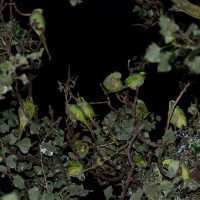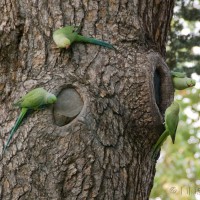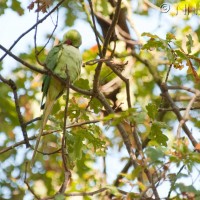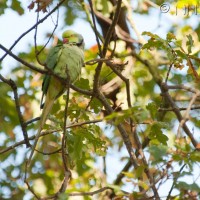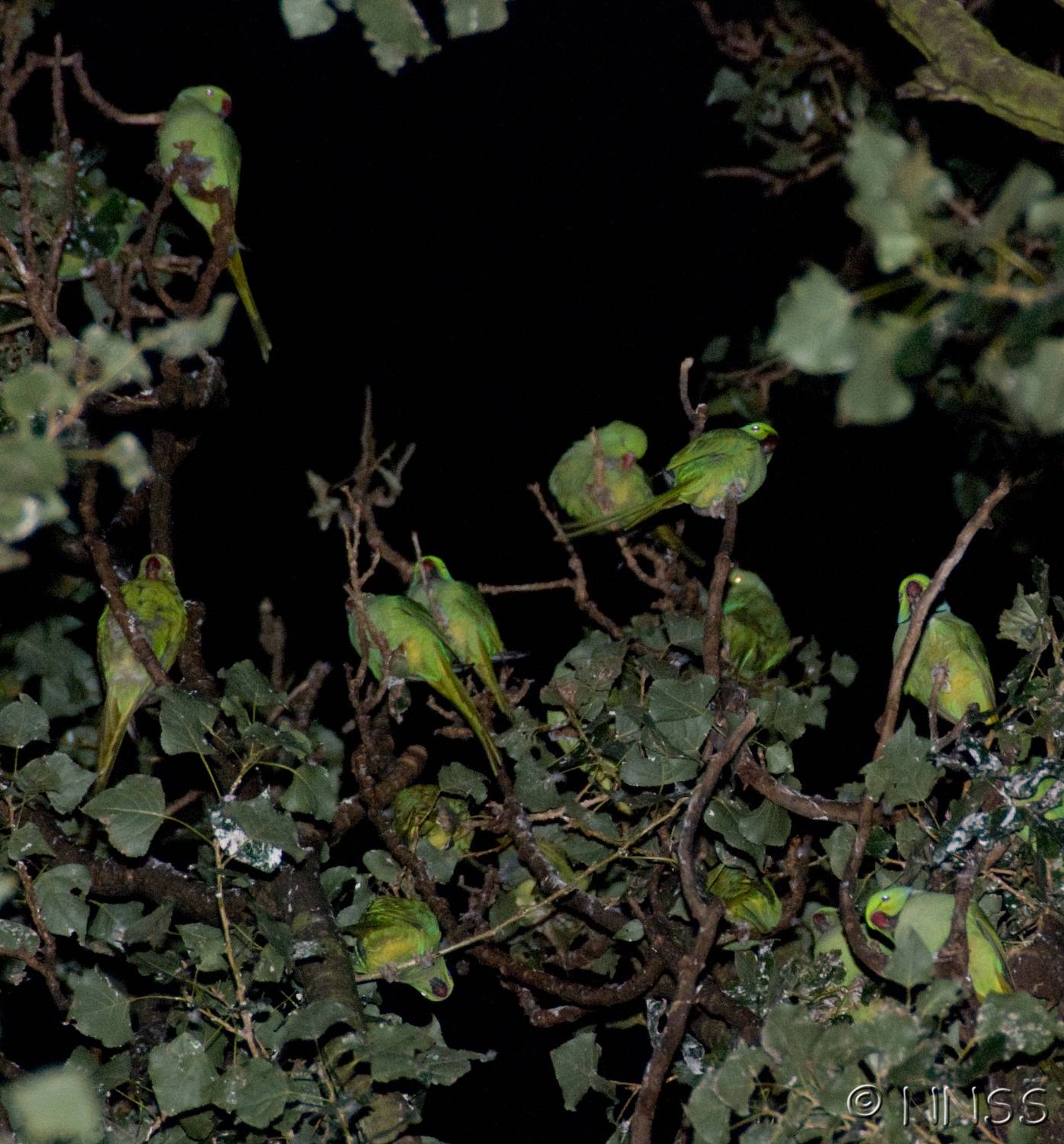
Ring-necked Parakeet - Psittacula krameri
Expand and collapse the sections below by clicking on the title or + / - icons.
Short description of Psittacula krameri, Ring-necked Parakeet
This species draws attention by its frequent loud screeching calls. Both sexes are predominantly bright yellowish-green, with long, pointed wings and tail, and a strong red bill. Males have a black throat and a black and pink neck ring.
Impact summary: Psittacula krameri, Ring-necked Parakeet
Ring-necked parakeets are considered a serious agricultural pest in the native range and have caused significant damage to crops in GB. They can compete for nest sites with native cavity nesters, and may carry diseases that could be harmful to poultry, native fauna and humans. They could be viewed as a noise nuisance in residential areas.
Habitat summary: Psittacula krameri, Ring-necked Parakeet
The species is found mostly in urban or suburban habitats, such as parkland, and especially in the London area.
Overview table
| Environment | Terrestrial |
|---|---|
| Species status | Non-Native |
| Native range | Africa, China, Indian Subcontinent, Indo-China, Afghanistan, Bangladesh, Burkina, Benin, Bhutan, Central African Republic, Ivory Coast, Cameroon, Djibouti, Egypt, Eritrea, Ethiopia, Ghana, Gambia, Guinea, Guinea-Bissau, Sri Lanka, Liberia, Mali, Myanmar, Mauritania, Niger, Nigeria, Nepal, Pakistan, Sudan, Sierra Leone, Senegal, Chad, Togo, Uganda, Vietnam |
| Functional type | Herbivore |
| Status in England | Non-Native |
| Status in Scotland | Non-Native |
| Status in Wales | Non-Native |
| Location of first record | Northrepps |
| Date of first record | 1855 |
Origin
The species is native across central Africa from west to east and has separate populations that occur from Afghanistan east through northern India to Myanmar. GB populations may originate mainly from India.
First Record
There is a long history of occurrence in GB, with a first record of breeding in Norfolk in 1855. However, the present naturalised population dates only from 1969.
Pathway and Method
The origin of the population is the pet trade and both the accidental and the deliberate release of birds from captivity.
Species Status
The species occupied 63 10-km squares in GB by 1988–91, nearly all in the London area. In 1996 a simultaneous roost count reported a population size of approximately 1,500 and by 200102 numbers had risen to approximately 5,900. Population modelling has revealed that populations in Greater London have increased by approximately 30% per year, and those in Thanet by 15% per year, but that the range has expanded by only 0.4 km per year in the Greater London area and so far not at all in Thanet. Further non-native populations are established widely across Europe, Asia, North America and southern Africa.
Dispersal Mechanisms
Parakeets are strong and confident fliers, but are non-migratory. The species’ habit of communal roosting involves some birds in daily roosting flights of 15 km or more. Birds appear to be reluctant to venture beyond commuting range to a roost, but dispersal could become rapid once the species establishes a broader network of roosting sites.
Reproduction
Likes most parrot species, they are dependent on large tree-holes as nesting cavities. Three to six eggs are laid, and an average 1.9 chicks are raised per nesting attempt. Breeding begins early, and there can be two broods per season.
Known Predators/Herbivores
The only natural predators thought likely to pose a threat are the sparrowhawk Accipiter nisus and goshawk A. gentilis.
Resistant Stages
None known.
Habitat Occupied in GB
The species is found mostly in urban or suburban habitats, such as parkland, but is expected to colonise more rural areas as the population grows. Large trees with natural cavities are required for nesting. Extensive use is made of bird feeders throughout the year.
There are currently centres of breeding across south and west London and in east Kent. Clusters of records around Birmingham, Manchester and South Yorkshire may indicate incipient colonisation of those areas. The species might occur almost anywhere as a recent escape.
Environmental Impact
There is some evidence, from Belgium, that ring-necked parakeets may be competing for nest holes with some native birds, such as nuthatch Sitta europea. Otherwise, the species currently appears to have little ecosystem impact.
Health and Social Impact
There is potential for noise nuisance, and risks to human health associated with fouling, in the vicinity of large communal roosts.
Economic Impact
In its native range in India, rose-ringed parakeet is considered one of the most destructive bird pests of agriculture, for example reducing maize yields. In GB, the species can damage fruit trees and has been reported to have reduced the output of a vineyard to only one sixth of the expected wine production (Hamilton 2004). Rose-ringed parakeets can carry diseases such as Newcastle disease and Cryptosporidium that also infect poultry, and might have impacts also on that industry.
Identification
Juniper, T. & Parr, M. (1998) Parrots: a guide to the parrots of the world. Pica Press, Robertsbridge, UK.
Biology, ecology, spread, vectors
Butler, C. (2002) Breeding parrots in Britain. British Birds, 95, 345–348.
Butler, C.J. (2003) Population biology of the introduced roseringed parakeet Psittacula krameri in the UK. Unpublished PhD thesis, Edward Grey Institute of Field Ornithology, Department of Zoology, University of Oxford.
Butler, C.J. & Gosler, A. (2004) Sexing and ageing Rose-ringed Parakeets Psittacula krameri in Britain. Ringing & Migration, 22, 7–12.
Butler, C.J. (2005) Feral parrots in the continental United States and United Kingdom: past, present, and future. Journal of Avian Medicine and Surgery, 19, 142–149.
Fletcher, M. & Askew, N. (2007) Review of the status, ecology and likely future spread of parakeets in England. CSL, York. full text
Pithon, J.A. & Dytham, C. (1999) Breeding performance of Ring-necked Parakeets Psittacula krameri in small introduced populations in southeast England. Bird Study, 46, 342–347.
Pithon, J.A. & Dytham, C. (1999) Census of the British ring-necked Parakeet Psittacula krameri population by simultaneous counts of roosts. Bird Study, 46, 112–115.
Pithon, J.A. & Dytham, C. (2001) Determination of the origin of British feral rose-ringed Parakeets. British Birds, 94, 74–79.
Pithon, J.A. & Dytham, C. (2002) Distribution and population development of introduced Ring-necked Parakeets Psittacula krameri in Britain between 1983 and 1998. Bird Study, 49, 110–117.
Management and impact
Hamilton, J. (2004) Pesky Polly. Article from Guardian online, url: http:society.guardian.co.ukenvironmentstory0,,1160291,00.html
Strubbe, D. & Matthysen, E. (2007) Invasive ring-necked parakeets Psittacula krameri in Belgium: habitat selection and impact on native birds. Ecography, 30, 578–588.
General
BirdLife International fact sheet
Forshaw, J.M. (2010) Parrots of the world. Christopher Helm, London.
Spotted this species?
Distribution map
View the Distribution map for Ring-necked Parakeet, Psittacula krameri from NBN Atlas
ID Sheet
ID Sheet for Psittacula krameri . See a full list of non-native species ID Sheets.
Risk assessment
Risk assessment for Psittacula krameri. See a full list of non-native species Risk assessments.

